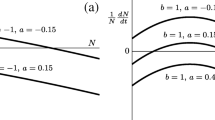Abstract
The two most popular and extensively-used discrete models of population growth display the generic bifurcation structure of a hierarchy of period-doubling sequence to chaos with increasing growth rates. In this paper we show that these two models, though they belong to a general class of one-dimensional maps, show very different dynamics when important ecological processes such as immigration and emigration/depletion, are considered. It is important that ecologists recognize the differences between these models before using them to describe their data—or develop optimization strategies—based on these models.
Similar content being viewed by others
References
Baker G L and Gollub J P 1990Chaotic dynamics (Cambridge: Cambridge Univ. Press)
Bailey J A 1984Principles of wildlife management (New York: Wiley)
Clark C W 1985Bioeconomic modelling and fisheries management (New York: Wiley)
Cooke L M 1965 Oscillation in the Simple Logistic Growth Model;Nature (London) 207 316
Edelstein-Keshet L 1988Mathematical models in biology (New York: Random House)
Hassell M P, Lawton J H and May R M 1976 Patterns of Dynamical Behaviour in Single Species Populations;J. Anim. Ecol. 45 471–486
Krebs C J 1978Ecology—The experimental analysis of distribution and abundance 2nd edition (New York: Harper and Row)
Macfadyen A 1963Animal ecology: Aims and methods (London: Pitman)
May R M 1974 Biological Populations With Nonoverlapping Generations: Stable Points, Stable Cycles, and Chaos;Science 186 645–647
May R M 1975 Biological Populations Obeying Difference Equations: Stable Points, Stable Cycles, and Chaos;J. Theor. Biol. 51 511–524
May R M 1976 Simple Mathematical Models With Very Complicated Dynamics;Nature (London) 261 459–467
May R M and Oster G F 1976 Bifurcations and Dynamic Complexity in Simple Ecological Models;Am. Nat. 110 573–599
McCallum H I 1992 Effects of Immigration on Chaotic Population Dynamics;J. Theor. Biol. 154 277–284
Murray J D 1989Mathematical biology (Berlin: Springer-Verlag)
Pimm S L, Jones H L and Diamond J 1988 On the Risk of Extinction;Am. Nat. 132 757–785
Soule’ M E (ed) 1987Viable populations for conservation (Cambridge: Cambridge Univ. Press)
Smith J M 1968Mathematical ideas in biology (Cambridge: Cambridge Univ. Press)
Stone L 1993 Period-doubling Reversals and Chaos in Simple Ecological Models;Nature (London) 365 617–620
Author information
Authors and Affiliations
Rights and permissions
About this article
Cite this article
Sinha, S., Parthasarathy, S. Behaviour of simple population models under ecological processes. J. Biosci. 19, 247–254 (1994). https://doi.org/10.1007/BF02703058
Received:
Revised:
Published:
Issue Date:
DOI: https://doi.org/10.1007/BF02703058




